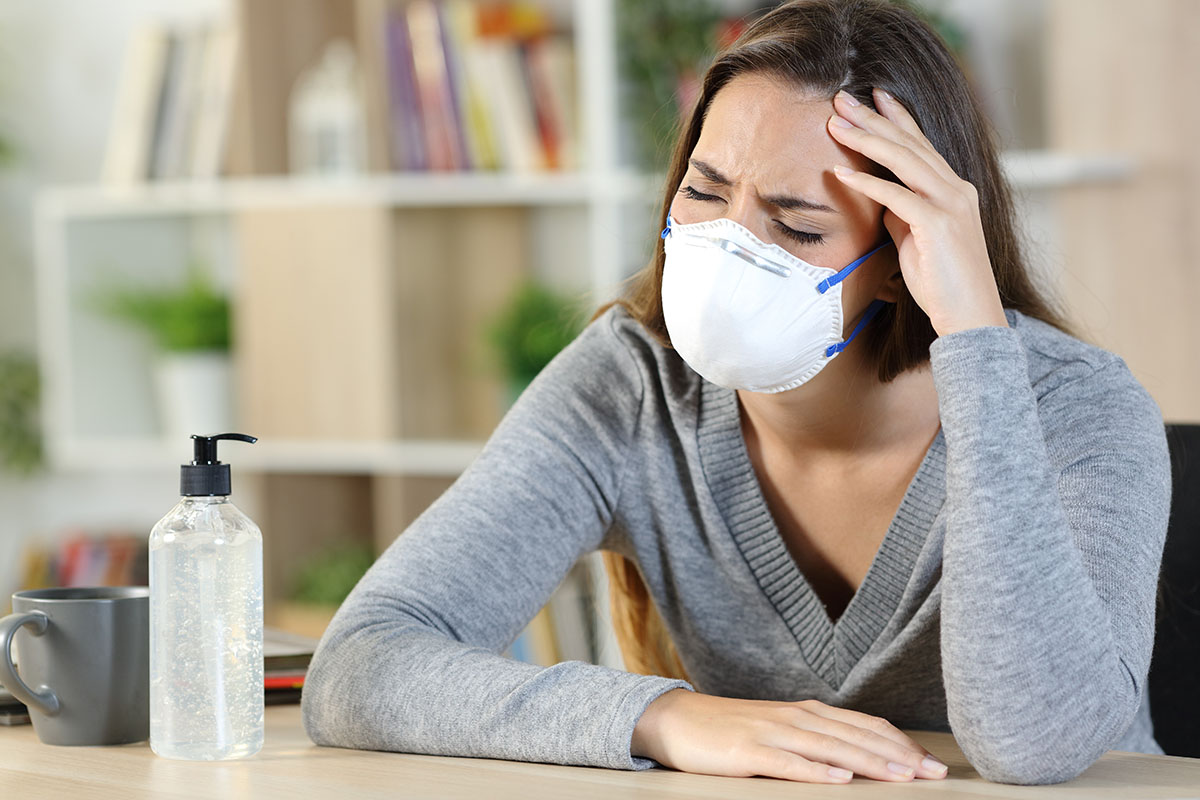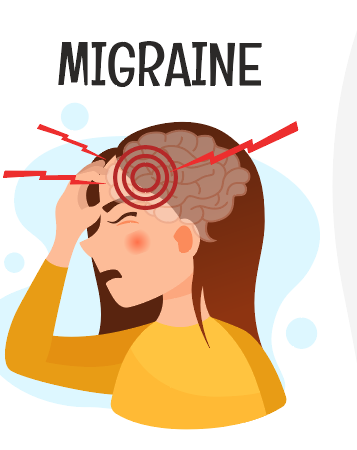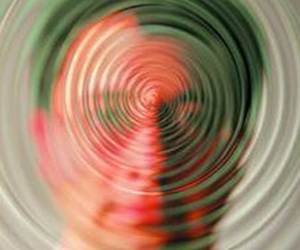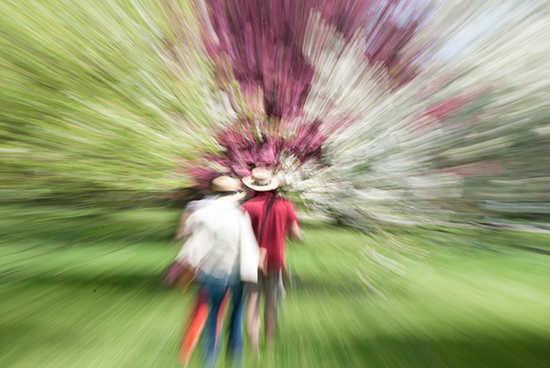
WWS Physical Therapy and Vestibular Rehabilitation
Doylestown, Pennsylvania
Healing, Function, Recovery, Health

We have all experienced headaches at some point or another in our life, whether it was a headache from a cold or a more significant debilitating migraine event. The WHO states that half to three-quarters of adults aged 18-65 have experienced headaches in the last year, and among those, 30% reported experiencing a migraine.
Headaches are classified as primary or secondary. Primary headaches include migraine, tension headaches, and cluster headaches. Secondary headaches include those experienced as the result of another underlying medical condition, such as a sinus infection, where the swelling and discomfort from the inflammation process cause head pain.
In our WWS Physical Therapy practice, we see individuals with various headache types. Our goal is not only to help reduce symptoms but to teach our clients life-long strategies to manage their symptoms better and reduce the frequency of recurrence. This may include exercises for the neck and shoulder region, sleep hygiene and stress management education, and working with patients to identify their personal headache triggers, which vary by individual.

Tension Headache:
Tension headaches are the most common primary headache disorder. They tend to be bilateral and often feel like a band around the head that is non-throbbing. Pain tends to be mild to moderate but not severe. Stress and muscle tension tend to be the driving factors behind these symptoms. Tension-type headaches typically do not cause photophobia (sensitivity to light), nausea, or vomiting.
Cluster Headache:
Cluster headaches are more common in males than females, at a reported ratio of 6 to 1. They cause severe pain on one side and tend to be localized behind one eye. This type of headache may cause the pupil to constrict on the involved side and cause the eye to water. Individuals may also experience sinus congestion or a runny nose on the involved side. These headaches also can be nocturnal, starting 1-2 hours after falling asleep.
Migraine Headache: Migraine is considered a neurological disease. During this neurological event, abnormal electrical activity may occur in the brain leading to changes in nerve activity and blood flow in the head. It is believed that inflammatory substances are released during this time. Attacks can include headache, usually unilateral, which is throbbing or pulsing. Nausea, vomiting, light sensitivity, and visual symptoms can also occur. Some individuals experience changes in speech, coordination, and even numbness associated with their episodes. Other migraine sufferers don’t experience the classic headache as their primary symptom and may experience dizziness, ear pain, or head fullness during an attack.
Females are 3x more likely to experience migraine than males. Migraines tend to run in families, and if one parent experiences a migraine, their child has a 50% chance of having one. If both parents have them, that risk increases to 75%.
Migraines occur in four phases that can take 8-72 hours to complete. These phases include the prodrome, which can cause irritability, depression, muscle stiffness, increased urination, sensitivity to light and sound, and other symptoms. The next phase is the aura. Not all migraine sufferers experience an aura, but when present, it can last from 5-60 minutes and may include visual changes, a “funny feeling,” changes in speech, tinnitus, and vision loss. Headache is the third phase, associated with the throbbing pain experienced. The headache can spread from one side to both and can be associated with depressed mood, anxiety, fatigue, and sensitivity to light and motion. Following the headache is the postdrome, which can last for a day or two after an event. This phase can cause feelings of depression as well as euphoria and difficulty concentrating.
Many patients are referred to our Vestibular Therapy practice for complaints of vertigo. Still, during our discussion and evaluation, it is often discovered that these patients also experience signs and symptoms consistent with migraine. A neurological screen is always completed as part of our dizziness evaluations; a headache questionnaire may also be completed when a migraine is suspected. When a headache is suspected, treatment may not be just positional maneuvers for BPPV but can also include migraine symptom management. This treatment plan in physical therapy can involve cardiovascular exercise, habituation exercises to desensitize the nervous system to various movements, and education regarding lifestyle modification. Education can include improving sleep hygiene, modifying screen use, stress management, and learning about common dietary triggers. For some patients, medication is necessary to manage their symptoms fully. We try to work with patients as they navigate their medication journey with their physicians.
If you suffer from headaches and want to manage your symptoms better or have questions about improving your activity tolerance, please consider contacting our physical therapy office for an evaluation. We would be happy to help you get started on your headache management journey, no matter where you are in the process.
Dr. Jenna McLane, Pt, DPT,
WWS Physical Therapy and Vestibular Rehabilitation
Doylestown, PA.
(215) 489-3234
The COVID-19 pandemic has changed our day-to-day lives for the past year. The virus is a severe acute respiratory syndrome coronavirus (SARS-CoV-2). Its rapid spread caused over 4 million deaths around the globe, changing the landscape of medicine forever.
Although the clinical features observed in COVID-19 patients mostly affect the respiratory and circulatory systems, there is mounting evidence about the neurological manifestations that impact nearly 30% of COVID-19 patients.
Common symptoms of COVID-19 include cough, fever, fatigue, body aches, and G.I. distress. Neurological symptoms reported in 30% of patients include loss of smell, loss of taste, migraine headaches, and dizziness. This is not surprising since dizziness is associated with viral infections of the inner ear.
Dizziness is a broad term and can mean different things to different patients. Dizziness described as lightheadedness can mean feeling like you are about to faint or feel unsteady when walking. In a study by Viola et al, 18% of COVID-19 patients complained of dizziness. Of those patients, 8% experienced lightheadedness, 8% had imbalance with walking, and 2% felt the true spinning of vertigo. In the study, 23% of patients reported symptoms of tinnitus (ringing in the ear), which was intermittent or constant in nature.
Is dizziness specifically caused by a COVID-19 infection? The quarantine lifestyle that we have been forced to adopt over the last year may also be a factor. The change in normal activity levels has specifically affected our senior population, which was most at risk. They went out much less, limiting their activities to walking around their home—for less than when they were out and about in their communities prior to the pandemic. The reduced socialization activities such as going to the food store, walking around a shop, going to the doctor’s office, and visiting with the family have taken their toll on the senior population, leading to decreased endurance for ambulation and reduced strength. For a population already prone to falls, this consequence of the pandemic can put seniors at higher risk of falling.
In addition, patients who did contract COVID-19 may have impaired breathing, which can cause patients to feel lightheaded with exertion. Inadequate circulation due to COVID-related cardiac problems can cause low blood pressure and impair the amount of oxygen circulated to the brain, which leads to dizziness. These patients would benefit from a supervised exercise program to work on endurance and balance, which can be provided by a Physical Therapist.

Vertigo and Migraine Headaches
Vertigo, a false sense of movement with spinning and feeling off-balance, is something that we commonly treat at WWSPT. We specialize in the care of disorders related to the vestibular system—most commonly vertigo. Since the pandemic began, we have seen an increase in vertigo-associated disorders and migraine-associated vertigo referred to our clinic. Many vertigo-related disorders are in post- COVID patients.
BPPV, a mechanical disorder of the inner ear where crystals are displaced causing acute vertigo, may develop within weeks after a COVID-19 infection, manifesting with short attacks of vertigo and spinning with associated nausea and vomiting. Vestibular Rehabilitation is effective in the treatment of BPPV, with maneuvers designed to move displaced crystals back to the proper place in the inner ear and reduce vertigo attacks.
Headache has been reported as the first symptom in 26% of people with COVID-19, and it presented within 24 hours for 62% of people with the virus. One-quarter of these patients have a headache that resembles a migraine, and 54% experience what resembles a tension-type headache.
Migraine headaches are a common neurological symptom, and changes in lifestyle due to the pandemic can influence the frequency of migraines and headaches. Changes in our work settings and hours, increases in screen time at home, increases in stress, and disruption in sleep, and regular exercise patterns all affect the frequency of migraines. Working at temporary desks and using poor posture can lead to tension headaches and cervical pain. In the early months of the pandemic, we saw many patients in the clinic for whom we were able to help make simple adjustments to their work-from-home setup to reduce migraine headaches.
A vestibular migraine is a common form of migraine that doesn’t always have a headache associated with it but can have other vestibular symptoms such as vertigo, nausea, light and sound sensitivity, and imbalance which are just as disabling as a headache. Many of the same triggers for migraine headaches can cause a vestibular migraine, but it is not as well recognized.
In a small set of post- COVID patients, headaches seem to linger long after the illness is over. They may benefit from pharmacological interventions and should see a neurologist for consultation.
An acute vestibular presentation in COVID-19 patients is “COVID-19 induced neuritis” of the vestibular nerve. These patients have sudden-onset severe vertigo, nausea, vomiting, and difficulty walking, without typical symptoms of fever or cough. These patients often need hospitalization and medical management before getting referred to vestibular rehabilitation.

Vestibular rehabilitation is effective in reducing symptoms of vertigo, visual-head motion sensitivity, and motion sickness. Exercise programs are designed to help overcome the false perception of movement due to errors in signals between the inner ear and the brain and to regain normal balance reactions. Coronavirus has challenged our lifestyles, health, and emotional well-being. Medical professionals and researchers continue to gather new information about the COVID-19 virus and how to manage post- COVID symptoms. Lingering symptoms of COVID such as dizziness, pain, and shortness of breath can continue to disrupt your life and limit you from returning to your normal activities. If you are experiencing any of these symptoms, consider a consultation at WWSPT with our Vestibular Physical Therapists.
Wendy Webb Schoenewald, PT, OCS, at
WWS Physical Therapy and Vestibular Rehabilitation
Doylestown, PA., 215-489-3234, wwspt@wwspt.com
A #migraine is not just a bad headache; it is a #neurological disease with extremely incapacitating neurological symptoms. About 12% of the population suffers from migraines; more specifically: 18% of American women, 6% of men, and 10% of children. It is most common between the ages of 25 and 55 and has been steadily increasing in occurrence over the past 30 years.
Surprisingly, about 90% of migraine sufferers have a family history of migraines but are often unaware until they are diagnosed. Approximately 50% of migraineurs go undiagnosed, and many self-treat or treat inappropriately for sinus or other non-migraine headaches. Although 25% of sufferers would benefit from preventive treatment, only 12% receive it.

Migraine is typically a severe, throbbing, recurrent pain—usually on one side of the head. Attacks are often accompanied by one or more of the following symptoms: visual disturbances; nausea; vomiting; dizziness; dysarthria; sensitivity to sound, light, smell, and touch; confusion; neck pain; and tingling and numbness in the extremities or face.
In 25% of migraines, the aura can occur minutes to hours before the attack. Aura presents as visual symptoms like geometric patterns, flashing lights, or blind spots; these indicate a migraine is about to strike. Attacks can last between 4 and 72 hours and are disabling. In 20% of attacks, neurological symptoms occur before the actual head pain begins. There are several types of migraines including ocular, headache, and vestibular.
Approximately 40% of migraine patients have accompanying vestibular syndrome involving disruption in their balance and dizziness during events. These patients often have vestibular symptoms that correlate with migraines such as motion intolerance like car sickness, visual motion sensitivity to busy environments, tinnitus, and spontaneous vertigo attacks like BPPV that can develop even after the migraine has passed.

Until recently, migraine was thought to have vascular origins; constriction and expansion of blood vessels were thought to be the cause. From high-tech imaging of patients during real-time migraine events, we now know that fluctuations in brain chemicals called neurotransmitters and abnormal electrical activity play a significant role in migraine attacks. The throbbing pattern of a headache has been synced with brain waves. Migraine causes aren’t understood completely, but genetics and environmental factors appear to play a role.
Treatment for migraines includes medication provided by your neurologist, but that is only one part of the story. Healthy habits and simple non-medical remedies sometimes stop migraines before they start by being aware of triggers.
The Mayo Clinic uses the acronym #SEEDS to teach people how to manage migraine pain with lifestyle and behavioral measures, as well as medication. SEEDS stands for #SLEEP well, #EAT wisely, #EXERCISE regularly, #DRINK fluids, and reduce #STRESS.

SLEEP well: establish regular sleep hours, waking up and going to bed at the same time every day. Unwind at the end of the day to help you relax. To promote better sleep, try listening to soothing music or taking a warm bath. Watch what you eat and drink before bedtime since caffeine, nicotine, and alcohol can interfere with sleep.
EAT wisely: don’t skip meals since fasting increases the risk of migraines. Avoid foods that trigger migraines such as aged cheese, chocolate, caffeine, alcohol, or drinks that contain artificial sweeteners such as aspartame. Other foods that are known triggers of migraine include certain fruits like figs, avocados, raisins, and bananas; and smoked or processed meats that contain nitrates.
It can be helpful to swap a hotdog (nitrates) for a hamburger to potentially reduce the risk of head pain. The same can be held true for cheeses – aged cheeses contain tyramine, which is an amino acid commonly found in foods known to trigger migraines. Instead, consider fresh feta, common American, or ricotta cheese. Additionally, you can swap raw veggies for pickles, since pickled foods are high in tyramine. EXERCISE regularly: regular exercise helps the body release certain chemicals that block pain signals to your brain. These chemicals can also help alleviate anxiety and depression which can make migraines worse. Maintaining a healthy weight through exercise and diet can provide additional benefits in managing migraines. Choose an exercise you enjoy such as walking, swimming, or cycling but start slowly and gradually increase your exercise.
DRINK fluids: maintaining hydration is an important part of preventing migraines. Make sure you are drinking enough water and not sugary drinks.
Reduce STRESS: manage your time wisely by delegating or dividing large projects into manageable chunks. Take breaks if you’re feeling overwhelmed to allow you to renew your energy. Relaxation with deep breathing and meditation for 10 to 20 minutes every day may also be helpful.
Migraine triggers that are less controllable include weather or barometric pressure changes. High humidity or hot temperatures can be potential migraine triggers. Bright sunlight can be a trigger, so wearing dark sunglasses is helpful. Hormonal fluctuations in women associated with menstrual cycles are another common trigger.
A healthy lifestyle and avoiding common triggers can be very helpful in managing migraines. Over-the-counter medications can be helpful but often aren’t enough. Medical management from your neurologist or pain specialist is an important part of treatment. As vestibular physical therapists, we can be helpful in managing some of the symptoms of migraine such as dizziness or vertigo attacks. We can help to develop a regular exercise program with an appropriate progression to reduce episodes of migraine. PT can provide treatment of cervical pain and muscle guarding associated with migraine symptoms.
Living with migraines is a daily challenge, but a healthy lifestyle and physical therapy can help.
Wendy Webb Schoenewald, PT, OCS
WWS Physical Therapy and Vestibular Rehabilitation
Doylestown, PA.
People are often referred to my office for treatment with a medical diagnostic code of “dizziness and giddiness.” This is an old term used when we didn’t understand the vestibular system, but it has remained in the medical coding system. I find this diagnosis interesting because giddiness makes me think of someone laughing and happy, but most of my patients with vertigo are not either of those things! They are struggling with dizziness throughout their day and are often frustrated and fearful.
People with vertigo describe many symptoms including dizziness, spinning, nausea, vomiting, migraines, loss of balance, difficulty walking, and mental fogginess. The balance center located in our inner ear, called the vestibular system, is essential to our body’s ability to function every day. Although it is small—the size of a peanut M&M’s®—when it doesn’t work properly, it becomes a big problem. It can keep you from walking safely and thinking properly and can cause you to feel disoriented and sick.

The vestibular system’s job is to coordinate our brain and vision with our postural system. This sounds simple, but anyone who’s had a vestibular event knows that, when this system is disrupted, it makes it very difficult to see clearly or move your head quickly. It can cause disorientation so intense that it can knock you over when trying to get out of bed. Fortunately, the specialty of physical therapy known as vestibular rehabilitation can be effective in restoring balance to this tiny but powerful system. Most people referred to my office say they’ve never heard of vestibular rehabilitation, but two out of three people have had some kind of vestibular dysfunction and are aware that therapies can be helpful. According to the National Institutes of Health, about 15% of American adults, or 33 million people, had balance or dizziness problems in the past year. Often patients aren’t clearly diagnosed, so it is part of my role to look for the signs and symptoms of a vestibular problem. Due to the widespread effect that the vestibular system has on proper functioning and coordination, determining a proper diagnosis can be challenging.
The most common vestibular disorder—which accounts for a third of vertigo presentations to dizzy clinics and emergency rooms—is BPPV or Benign Paroxysmal Positional Vertigo. It is more common in adults but also presents in the younger population due to its relationship to migraine and concussion. BPPV affects the inner ear, causing spinning spells that typically last one minute or less and are provoked by a change in body or head positions like looking up to a top shelf or getting out of bed. In the inner ear, there are three structures called Semicircular Canals that sense rotational head movements. Calcium carbonate crystals sometimes get loose, and, when they find their way into these canals, they trigger a spinning sensation associated with nausea, vomiting, imbalance, and discomfort. This condition can be treated with maneuvers designed to put the crystals back into their proper location, such as the Epley maneuver. For more detailed information on BPPV, visit Http:// bit.ly/WWSPTFeb2016.

Vestibular migraine is the second most common cause of dizziness. Patients with migraine can have associated vertigo occurring with a migraine headache, afterward, or even without a headache at all. About 12% of the population suffers from migraines, with a higher prevalence in women than men. About 10% of children experience migraines, but it is most common between the ages of 25 and 55. Vestibular migraine is often preceded by visual symptoms of aura, or warning, including neurological symptoms like sensitivity to light and sound, as well as nausea and imbalance. Management of vestibular migraine includes being aware of what may trigger your migraine, drinking lots of fluids, and exercising regularly. BPPV can trigger a vestibular migraine but is also a common sequela of a migraine attack. Learn more about vestibular migraine at http://bit.ly/WWSPTOct2018.
Ménière’s disease is a well-known disorder that can cause spells of disabling vertigo and is commonly associated with hearing loss. It is thought to be a fluid imbalance problem in the inner ear, causing vertigo symptoms lasting a full day that become more disabling with each attack. The mechanism of Ménière’s is not clear, but the attack can occur frequently without a specific trigger, making it more difficult to manage.
Vestibular neuronitis, also called labyrinthitis, is an acute disorder of the inner ear caused by a virus attacking the inner ear and reducing input to your brain, which causes severe and sudden onset of dizziness and imbalance. Some patients also have associated hearing loss. Often these patients cannot get out of bed for 1 to 2 days and have symptoms of nausea, vomiting, and imbalance. In this disorder, there is damage to the vestibular nerve, so recovery can take between 3 and 12 weeks depending on the severity. The research shows that starting vestibular rehabilitation as early as possible facilitates a faster recovery.
The impact of vestibular disorders on a person’s lifestyle is considerable. They cause a significant interruption of daily activities and an increased need for medical leave from work. Most vestibular patients see 3 to 4 physicians before being properly diagnosed, affecting patients fiscally as well. Vestibular disorders are shown to impact mood, causing increased depression and anxiety. They affect cognitive status because patients are working harder to function which leads to difficulties in spatial memory and attention or “brain fog.”
The team of professionals at WWSPT is committed to the proper evaluation and diagnosis of patients with vestibular dysfunction. This helps us utilize the appropriate strategies and treatment to return you to a more active, healthy lifestyle. If you’re dizzy, please give us a call today so we can help you on the road to recovery.
Wendy Webb Schoenewald, PT, OCS
WWS Physical Therapy & Vestibular Rehabilitation
1456 Ferry Road, Suite 601
Doylestown, Pennsylvania
215.489.3234
We strive to provide an environment of recovery and healing for our clients, to allow them to advance their health and return to function, recreation or sports. It is our belief that Physical Therapy is the initial link in the healthcare system for Musculoskeletal and Balance related issues and we are the true experts on exercise. We look forward to a long term relationship with our patients and their families over their life span and hope to become their practitioner of choice for acute musculoskeletal issues, neuromuscular issues as well as reoccurring events limiting their Wellness. We want to be a part of our patients Healthy living and Healthy aging.